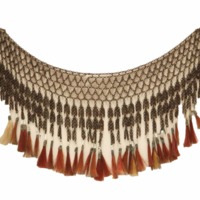Tagalog headgear (salakot)
Text
Share this
Media
Images
Map National Anthropology Museum Madrid
Metadata
Publisher
National Anthropology Museum Madrid
Date
19th century
Identifier
CE2555
Origin
Central Luzon, Philippines
Connection to Philippines
Tagalog origin
Materials
Silver, vegetable fibers ("nito" vine, "guaco" vine), cane
techniques: embossing, basket weaving technique, velvet
techniques: embossing, basket weaving technique, velvet
Physical Dimensions
height: 17 cm
length: 34 cm
width: 27.50 cm
length: 34 cm
width: 27.50 cm
Provenance
Brought over for an exhibition on the Philippines, Mariana Islands, and Caroline Islands in Madrid in 1887.
Short description
Hat made of woven “nito” (a black vine) and lined with black velvet. All of the outer surface of the hat is decorated with floral and animalistic motifs in embossed silver. On the panel at the top of the hat, the initials of the hat's owner, "J. M.," are also indicated in embossed silver.
Salakots are an important garment in Tagalog men's clothing and are indispensable in rural areas. The making of salakots was a widespread artisanal craft among women, and they came in various shapes and materials. The most decorated hats were saved for festivals and ceremonies; those decorated in silver symbolized the local authority established by Spain, and those who wore them were called "little governors" or "captains," though they did not correspond to these roles in their traditional sense. ( Google Arts: https://artsandculture.google.com/asset/salacot-unknown/EgEucclDo4WvWg)
Salakots are an important garment in Tagalog men's clothing and are indispensable in rural areas. The making of salakots was a widespread artisanal craft among women, and they came in various shapes and materials. The most decorated hats were saved for festivals and ceremonies; those decorated in silver symbolized the local authority established by Spain, and those who wore them were called "little governors" or "captains," though they did not correspond to these roles in their traditional sense. ( Google Arts: https://artsandculture.google.com/asset/salacot-unknown/EgEucclDo4WvWg)
Display status
On Display
Acknowledgements
Photos by Pablo Linés Viñuales and Miguel Ángel Otero
Official Website
Collection
Cite this Page
“Tagalog headgear (salakot),” Mapping Philippine Material Culture, accessed April 25, 2024, https://philippinestudies.uk/mapping/items/show/2535.
Geolocation
Sensitive Content
Mapping Philippine Material Culture collates digital material from institutions, and some of this material is inherently colonial and contains words, terms and phrases that are inaccurate, derogatory and harmful towards Filipino and Filipino diasporic communities. Catalogue transcriptions, book titles, exhibition titles and museum titles may contain harmful terms. We recognise the potential for the material to cause physical and mental distress as well as evoke strong emotions. Owing to the scale of the collection’s data, a process to implement sensitive-content warnings in the displayed data is still incomplete. The material within the catalogue does not represent Mapping Philippine Material Culture’s views. Mapping Philippine Material Culture maintains a strong anti-colonial, anti-racist position and affirms its support for centring the humanity of historically marginalised and disenfranchised communities.
Facebook Twitter



